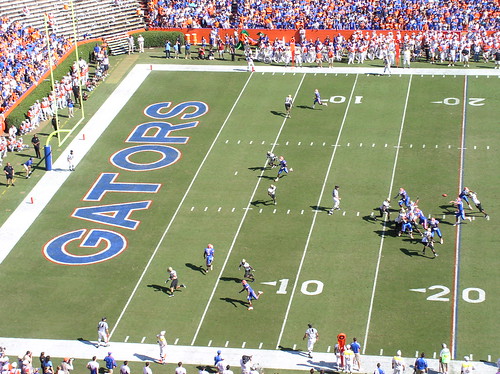
Considering Tim Tebow has had experience in both the college and professional levels of football, I thought it would be interesting to compare and contrast the two. Before researching the similarities and differences I didn’t even realize that these two levels differed from each other. Turns out that there is a few major differences. Hopefully you will learn something new while reading this post, like I did while researching this topic.
According to the article College Football vs. NFL Football (http://hogmonster.com/college-nfl/), the main idea is that NFL players are paid professionals and have fewer restrictions than college players. The NFL superstars don't have to attend classes or attain a certain GPA to stay in their sport. They also get paid for playing in the NFL, National Football League. Another piece of information that sets apart the two levels of football is the playing fields in terms of hash marks, yard markers. One more key piece of information mentioned in this article is the conditions that determine when a play is over. The hash marks and end play conditions are mentioned in a later paragraph.
Another article, (http://stilettosetsports.com/college-football-vs-nfl/), states that the seven major differences between the two levels of football do not include the ones mentioned in the first article except for hash marks and end play conditions. This source says that the differences include the two-minute warning, two-point conversion, rules for the end of a play, the game clock, the almost-out-of-bounds catch/pass reception, overtime, and the hash marks. There is a mandatory two-minute time out in the NFL before the end of a game. These two minutes give both teams time to plan their final plays. There is no two-minute warning in college. The two-point conversion is another difference. In college the conversion starts on the 3-yard line and the 2-yard line in the NFL. The game clock is another variation between the two levels. It continues to run in the NFL after a first down is achieved unless a player is out of bounds or time is called. In college, the clock stops whenever a first down occurs. The almost-out-of-bound catch/pass reception differs by literally one foot, the body part. For the catch to be determined if it counts, a college player has to get at least one foot in-bounds for the catch to be considered good. In the NFL, a player must get both feet down in-bounds. See what I mean about differing by literally one foot. The end of a play rules, hash marks, and overtime are all mentioned in the next two paragraphs.
The similarities between article 1 (http://hogmonster.com/college-nfl/) and article 2 (http://stilettosetsports.com/college-football-vs-nfl/) are about the rules for the end of a play and the hash marks on the field. In college a play ends when on of the ball carrier's knees touches the ground. In the NFL the ball carrier must be forced down by another player in order for the occurring play to end. In the NFL the hash marks, yard markers, are farther from the sidelines which is about 70 feet. In college the hash marks are closer to the sidelines which is about 60 feet. Since the NFL lines are farther from the sidelines, their fields are actually 20 feet smaller than college fields.
Last Year I watched a college game between Michigan State University and the University of Georgia and they went into three overtimes before Michigan State scored and won the game. This shows the rules for college overtime. Between the NFL and college, the overtime rules are completely different. When an NFL team goes into overtime, they play a sudden-death quarter. They flip a coin to determine who gets to try and score first. The first team to score wins the whole game. If no one scores in the sudden-death quarter, then the game is declared a tie. In college, there is no such thing as a game ending in a tie. For them, overtime goes until someone wins. Each team gets and equal chance to try to score and win the game. Another difference that the articles mentioned is that college players have smaller bodies than NFL players. This is true because they don’t have much time to work out and train like the professionals do. They also don't have personal doctors or trainers to help keep their performances, minds, and bodies in shape. Both college and professional players have access to gyms and a number of products but more resources go to the NFL teams than the college teams.
I think that the differences between the two levels of football may confuse many people. Due to the differences, many people prefer either college or professional football, not both. I am one of the few people who like both professional and college football. Until I researched similarities and differences between the the levels, I didn’t realize that there were any differences. I don't care that the NFL and college differ a little from each other. As long as my teams are playing well and winning then I am happy. I would be even happier if the Jets allow Tim Tebow more playing time than he has now. After comparing and contrasting college football and professional football, I will probably be able to spot the differences between the two.
No comments:
Post a Comment